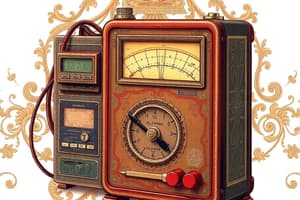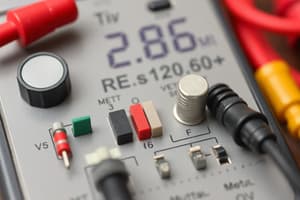Podcast
Questions and Answers
Which feature distinguishes the resistance readings on an analog multimeter from voltage and current readings?
Which feature distinguishes the resistance readings on an analog multimeter from voltage and current readings?
- They are always displayed in negative values.
- They utilize a needle-shaped rod.
- They have a logarithmic scale. (correct)
- They require a digital interface for measurement.
What is the primary function of the zero adjustment on an analog multimeter?
What is the primary function of the zero adjustment on an analog multimeter?
- To ensure accurate resistance measurements. (correct)
- To calibrate the voltage readings.
- To align the needle to the correct scale.
- To switch between different measurement functions.
What is a key characteristic of a digital multimeter compared to an analog multimeter?
What is a key characteristic of a digital multimeter compared to an analog multimeter?
- It offers a visual numeric display of values. (correct)
- It uses a mechanical needle to indicate measurements.
- It cannot measure current directly.
- It requires a zero adjustment for resistance measurements.
Which component of the analog multimeter directly affects the reading of measurements on the scale?
Which component of the analog multimeter directly affects the reading of measurements on the scale?
What type of scale is generally used for voltage readings on an analog multimeter?
What type of scale is generally used for voltage readings on an analog multimeter?
Flashcards
Multimeter
Multimeter
A versatile instrument used to measure voltage, resistance, and current.
Analog Multimeter
Analog Multimeter
A multimeter that uses a moving needle to display readings.
Digital Multimeter
Digital Multimeter
A multimeter that displays readings on a digital screen.
Multimeter Scale
Multimeter Scale
Signup and view all the flashcards
Zero Adjustment
Zero Adjustment
Signup and view all the flashcards
Study Notes
Multitester Overview
- A multitester, sometimes called a VOM (voltmeter, ohmmeter, milliammeter), is the best instrument for measuring voltage, resistance, and current.
- Two main types exist: analog and digital.
Multitester Parts
Pointer
- The needle-shaped rod that moves across the meter scale.
- Mechanically linked to a moving coil.
- Displays measured values on the multitester scale.
Range Selector Knob (Selector Switch)
- Allows selection of different functions and measurement ranges on the meter.
Adjustment Screw
- Used to align the pointer to the zero position on the scale.
Scale
- A series of markings for reading the value of a measured quantity.
- Voltage and current scales typically have equal divisions (linear).
- Resistance scales have unequal divisions (logarithmic).
Zero-ohm Adjusting Knob
- Used to precisely adjust the pointer's zero position before resistance measurements.
Test Probes
- Used to connect the circuit to the electrical components being tested.
- Red probe is positive (+).
- Black probe is negative (-).
Studying That Suits You
Use AI to generate personalized quizzes and flashcards to suit your learning preferences.
Related Documents
Description
This quiz covers the basics of multitesters, including their types and fundamental components. You'll learn about parts such as the pointer, range selector knob, and various scales used for measurement. Test your knowledge on the functionalities and adjustments related to these essential measuring instruments.




